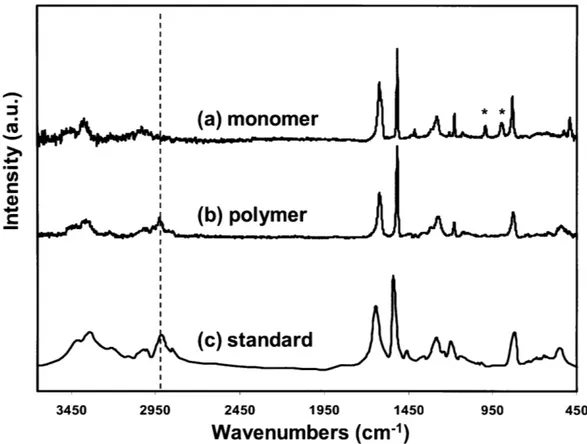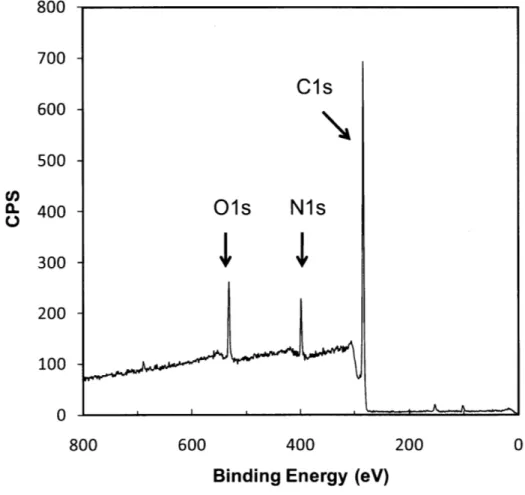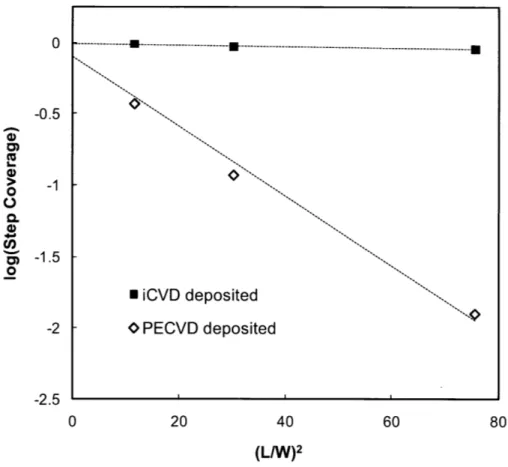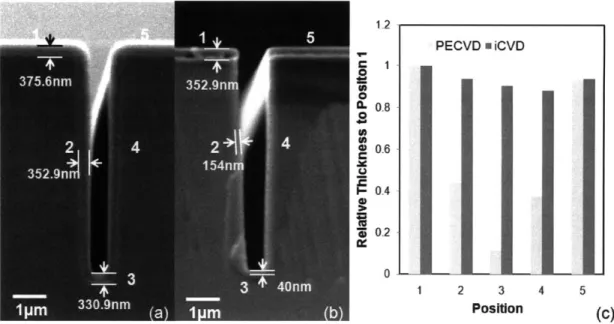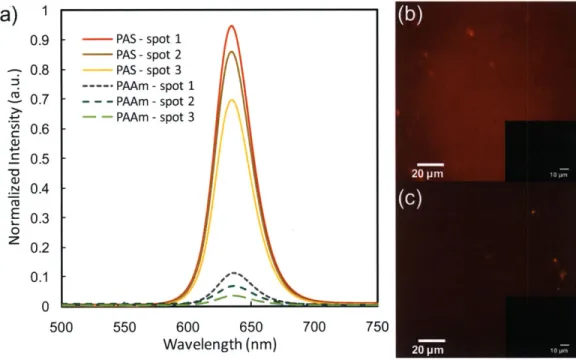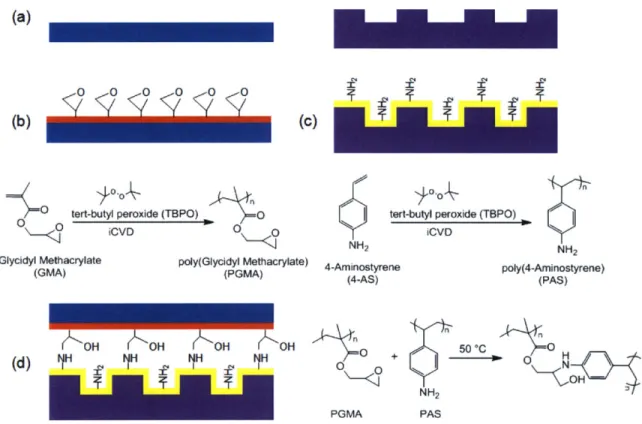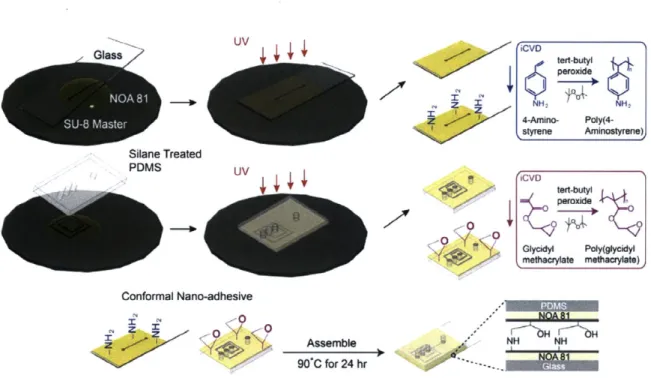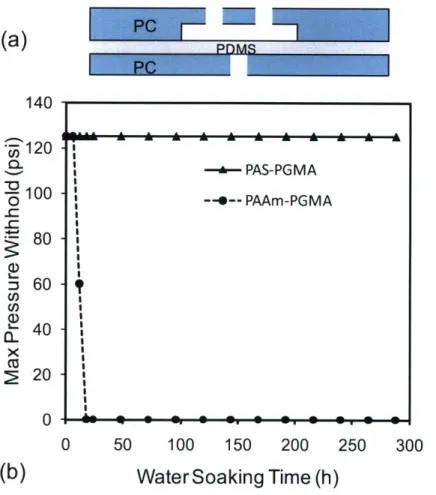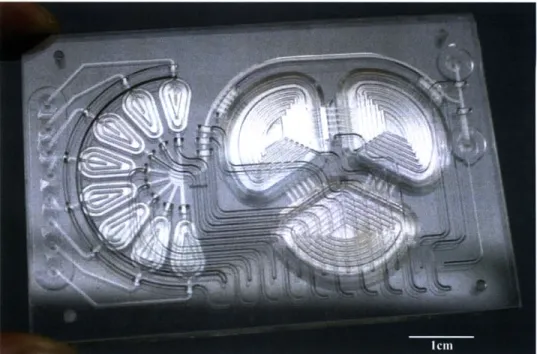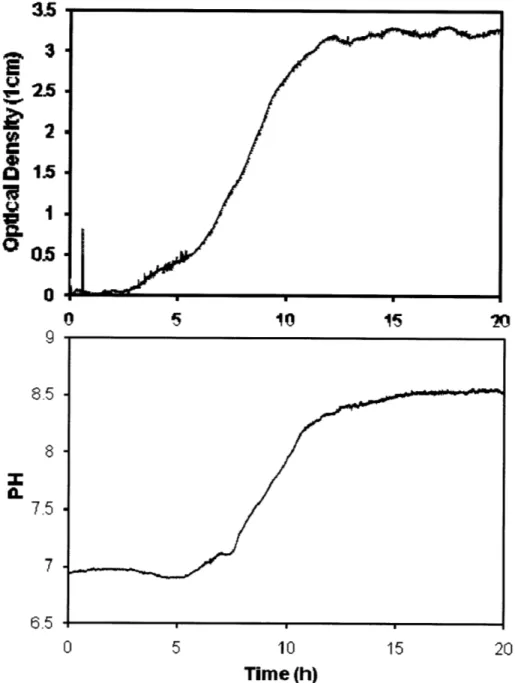Amine Functionalization by Initiated Chemical
Vapor Deposition (iCVD) for Interfacial Adhesion
and Film Cohesion
byJingjing Xu
Master of Philosophy, Materials Science
University of Cambridge, Cambridge, United Kingdom, 2006 Bachelor of Engineering, Polymer Science and Engineering Beijing University of Chemical Technology, Beijing, China, 2005
Submitted to the Department of Chemical Engineering in Partial Fulfillment of the Requirements for the Degree of DOCTOR OF PHILOSOPHY IN CHEMICAL ENGINEERING
AT THE
MASSACHUSETTS INSTITUTE OF TECHNOLOGY June 2011
© 2011 Massachusetts Institute of Technology. All rights reserved.
Signature of Author MASSACHUSETTS INSTITUTE OF TECHNOLOGY
JUN
13
2011
LiPA
RCIES
ARCHIVES
Department of'Chemical Engineering
Mav23 201 1
Certified by
Karen K. Gleason Professor of Chemical Engineering Thesis Supervisor Accepted by
William M. Deen Professor of Chemical Engineering Chairman, Committee for Graduate Students
Amine Functionalization by Initiated Chemical
Vapor Deposition (iCVD) for Interfacial Adhesion
and Film Cohesion
by
Jingjing Xu
Submitted to the Department of Chemical Engineering on May 23, 2011 in Partial Fulfillment of the
Requirements for the Degree of
Doctor of Philosophy in Chemical Engineering
Abstract
Amine functional polymer thin films provide a versatile platform for subsequent functionalization because of their diverse reactivity. Initiated chemical vapor deposition (iCVD) is a polymer chemical vapor deposition technique that utilizes the delivery of vapor-phase monomers to form chemically well-defined polymer films with tunable conformality and property. In this thesis work, amine functional iCVD poly(4-aminostyrene) (PAS) thin films were synthesized for the first time. The pendant amine groups enable the formation of a robust nanoadhesive with complementary epoxy functional groups. Bonded devices able to withstand >150 psi were achieved by combining polydimethylsiloxane (PDMS) and a wide variety of polymeric materials. Additionally, the all-iCVD nanoadhesive bonding process displays high resistance against hydrolytic degradation (>2 weeks). In addition to bonding, the iCVD layers remaining in the microfluidic channels provide functional groups for subsequent reaction and also act as diffusion barriers against oxygen permeation into the devices. Two applications utilizing this nanoadhesive bonding technique were introduced, including for growth of E. coli in the iCVD-bonded chips and fabrication of gas impermeable microchannels for microparticle synthesis from organic solvents. Another amine functional conformal coating has been designed, synthesized, and characterized. The novel alternating copolymer thin film synthesized from maleic anhydride and aminostyrene via iCVD extensively self-crosslinks after gentle heating. The annealed copolymer films display an elastic modulus exceeding 20 GPa, far greater than typical polymers (0.5-5 GPa). Moreover, the cross-linked films maintain their flexibility, neither cracking nor delaminating with repeated flexing. This achievement represents a significant advance in the fabrication of tough, durable, conformal, functional coatings. Furthermore, the highly crosslinked coating material has oxygen permeability lower than leading commercially available permeation barrier films, making it an attractive material for electronics or food industries. Also described is the utility of a new initiator, tert-butyl peroxybenzoate (TBPOB), for the iCVD synthesis. Using TBPOB instead of tert-butyl peroxide (TBPO), the rate of iCVD film growth increased by a factor of up to -8 at comparable conformality and lower the filament temperature from -250 'C to -150 'C at a comparable deposition rate. The faster deposition rates improve the economics of the iCVD process and the ability to initiate polymerizations at a much lower filament temperature reduces heat load to substrate, which is advantageous for temperature sensitive polymeric substrates or monomers that decompose at high temperatures Thesis Supervisor: Karen K. Gleason
Title: Alexander and I. Michael Kasser Professor of Chemical Engineering, Associate Dean of Engineering for Research
ACKNOWLEDGEMENTS
Completing a PhD is truly a marathon event, and I would like to thank those who helped me complete this journey. First and foremost is my advisor, Karen Gleason, for giving me the opportunity to join the Gleason group and for her encouragement, guidance and support throughout the research project. I would not have been able to complete this journey without Karen's help. Thank you, Karen for your patience, kindness, and great advice, not only in research but also in all aspects of life. Your dedication to students and to research is very inspiring.
I would like to express my sincere thanks to my committee: Professor Klavs Jensen
and Professor Patrick Doyle for their invaluable guidance and support. I appreciate the discussions and the opportunities to collaborate with their graduate students, which enable me to approach my projects from different angles.
I am heartily thankful to the many graduate students and post-docs I have worked
with in Gleason's group. Wyatt Tenhaeff, thank you for all the kind help and great suggestions. Your insights and comments were invaluable over the years. Tyler Martin, thanks for first showing me the beauty of iCVD. Salmann Baxamusa, it is always a great pleasure to talk with you. Sreeram Vaddirajju, thanks for all the help with my troublesome pumps and the inspiring discussion. Sung Gap Im, I appreciate your help with the nanoadhesive bonding. Gozde Ozaydin-Ince, it was great to have your company at ISN! I owe a great thank you to Ayse Asatekin, whose ability to rapidly assess the worth of ideas and algorithms is really amazing. Mahriah Alf, I enjoyed sharing the reactor with you and solving the reactor problems together. Miles Barr, you are really the most original and creative person
I have ever known well. Christy Petruczok, thank you for your help with the Gaussian
simulation. Rong Yang, thanks for providing good company and encouragement throughout my thesis-writing period.
In addition to my labmates, gratitude is also expressed to my collaborators, without whose help this work would not have been possible. Kevin Lee, thank you for providing sound advice, lots of good ideas, and good teaching of the knowledge in the microfluidics area. Ki Wan Bong, I was lucky to have the opportunity to work with you during my final stage of PhD and I am grateful to your support, understanding, and patience while we work together. Jeewoo Lim, thank you for synthesizing the amplifying fluorescent polymers.
I would also like to thank all my friends who helped me get through five years of
graduate school, especially, Ying Diao. Dear diaodiao, your friendship is a treasure for me and without your help in countless ways it was impossible for me to go this far. I was so fortunate to have the greatest roommates in the world: Fei Chen, Jie Chen, and Yin Fan. I appreciate the emotional support, comraderie, entertainment, and caring they provided. I also thank some of my friends and classmates: Qing Han, Fei Liang, Ming Yang, Ben Lin, Sue Kyung Suh, David Couling, Nicholas Musolino, and Jonathan DeRocher. They each helped make my time in the PhD program more fun and interesting.
I also thank the supporting staff in the department including Gwen Wilcox, Craig
Abernethy, Suzanne E Maguire, Katie Lewis and Christine Preston.
Finally, I am deeply indebted to my parents for providing a loving environment for me, and for their continuous support and unwavering faith in me. Mum and dad, thank you for your wholehearted support of my educational and career goals, despite of the fact that I am the only child in the family but have to move half way around the world. Thank you for teaching me the value of education and for instilling in me confidence and a drive for pursuing PhD.
Most importantly, I am eternally grateful to my husband, Howard, for his constant love and strength throughout the years. He seemed to know just when I needed encouragement and without his patience, support, and understanding, I could never made it this far. Howard, you were the wind beneath my wing.
Table of Content
Abstract...2
Table of Content... 5
List of Figures...8
List of Tables ... 13
List of A cronym s and A bbreviations ... 14
CH A PTER O N E ... 15
Introduction ... 15
1.1. Background ... 16
1.2. Initiated Chem ical V apor D eposition (iCV D ) ... 17
1.3. Functional Polymers by Vapor Deposition Techniques ... 19
1.4. Application of CV D Polym ers to M EM S Sealing ... 24
1.5. Scope of Thesis ... 27
References ... 30
CH A PTER TW O ... 32
Initiated Chemical Vapor Deposition ofAmine-Functionalized Thin Films' ... 32
Abstract ... 33
2.1. Introduction... 34
2.2. Experim ental ... 36
2.2.1. Film Preparation ... ... ... ... 36
2.2.2. Film Characterization ... . ... ... 37
2.2.3. Attachm ent of CdSe/ZnS Quantum D ots... 38
2.3. Results and D iscussion... 39
2.3.1. Film Structure Analysis ... 39
2.3.2. Conformal Coverage ... 42
2.3.3. Film Derivatization with CdSe/ZnS Quantum Dots ... ... 44
2.4. Conclusion ... 46
A cknow ledgem ents ... 46
CHAPTER THREE ... . ... 48
Nanoadhesive Bonding Technique Using Amine-functional Films... 48
A b stract ...-.-... . . ... 49
3.1. Introduction ... . . 50
3.2. E xperim ental ... 52
3.2.1. Bonding of Prototype Microfluidic Devices and Bond Strength Test ... 52
3.2.2. Fabrication of Bioreactors Made from Polycarbonate Plastics for Cell g ro w th ... 5 4 3.2.3. Microparticle Synthesis in Gas Impermeable Channels ... 55
3.3. R esults and D iscussion... 56
3.3.1. Adhesive Bonding and Bond Strength of Sealed Microfluidic Devices... 56
3.3.2. H ydrolytic R esistance... ... 57
3.3.3. Growth of E. coli in iCVD Bonded Bioreactor... 59
3.3.4. Device fabrication for Microparticle synthesis ... 64
3.4 . C onclusion ... . 68
A cknow ledgem ents... 69
R eferen ces ...- ... ---... 70
CHAPTER FOUR...71
The Design and Synthesis of Hard and Impermeable, yet Flexible, Conformal O rganic C oatings ... .. 71
A b stract ... ... --... - ---...72
4 .1. Introduction ... . . 73
4 .2. E xperim ental ... 76
4.3. R esults and D iscussion... .. 79
4.3.1. Deposition Rate ... ... 79
4.3.2. F ilm Structure A nalysis ... 80
4.3.3. Mechanical Property Analysis ... ... ... 83
4.3.4. Oxygen Permeability .. ... ... ... .... 90
4 .4 . C onclu sion ... ... . 92
A cknow ledgem ents ... 92
R eferences ...-... .... 93
CHAPTER FIVE ... 95
Low-temperature iCVD Process Using Tert-Butyl Peroxybenzoate as an Initiator.. 95
A b stract ... ... --...- . ---... 96
5.2. Experim ental ... 100
5.2.1. D eposition Setup ... 100
5.2.2. Film Characterization ... 101
5.3. R esults and D iscussion... 102
5.3.1. Deposition Kinetics ... 102
5.3.2. Confirm ation of Polym erization by F TIR ... 105
5.3.3. Compositional Analysis by XPS ... 107
5.3.4. Conform ality A nalysis by SEM ... 109
5.4. Conclusion ... 113
A cknow ledgem ents ... 114
References ... 115
C H A PT ER SIX ... 117
Conclusions ... 117
A PPEN D IX A ... 125
Integration of Amplified Fluorescent Polymer (AFP) Detection Schemes into M icrofluidic System s ... 125
List of Figures
Figure 1-1. (a) iCVD reactor scheme. (b) iCVD deposition mechanism... 17 Figure 2-1. Fourier transform IR (FTIR) spectra of (a) 4-aminostyrene (4-AS) monomer, (b) iCVD deposited poly(4-aminostyrene) (PAS), and (c) PAS standard from Polysciences. Asterisks (*) represent signature vinyl bonds and dotted line refers to the sp3 C -H stretching. ... 40 Figure 2-2. XPS survey scan for detection of the atomic concentration of oxygen, nitrogen, and carbon... 4 1 Figure 2-3. Step coverage as a function of aspect ratio square. The dashed line (R2>0.99) represents the linear best-fit line for the data and its slope is proportional to the sticking probability of the initiating radical. Here the three different aspect ratios for the trenches are 8.7, 5.5, and 3.4 respectively... 43 Figure 2-4. Cross-sectional SEM images films of (a) iCVD PAS, (b) PECVD PAAm, and (c) the relative thickness variation of films with respect to the trench position in (a) an d (b )...4 4 Figure 2-5. Amine functional groups density comparison between iCVD PAS and PECVD PAAm. (a) photoluminescence (PL) results. Three different spots were measured for each sample. Fluorescence micrographs of (b) iCVD PAS and (c) PECVD PAAm. The images insert in the top right of (b) and (c) represent background when there is no quantum dots attached to the surface...45 Figure 3-1. Adhesive bonding process. (a) Substrate cleaning by oxygen plasma for 0.5-1 min (b) iCVD deposition of Glycidyl Methacrylate (c) iCVD deposition 4-Aminostyrene (d) Adhesive layer curing at 50 'C for 24 hours. ... 53
Figure 3-2. Schematic of the bioreactor design. ... 54 Figure 3-3. Fabrication process of gas impermeable channels... 56 Figure 3-4. Hydrolytic resistance study. (a) Schematic of a PC-PDMS-PC structure used in the blister test (b) plot of the channel maximum pressure versus water soaking
time. Dotted line shows a markedly bond strength decrease in devices utilized PAAm-PGMA chemistry. The bond starts to degrade after 6 hours and completely fails after 18 hours. The solid line represents bond strength for devices utilized PAS-PGMA chemistry. It remains almost unaffected even after 2 weeks. ... 58
Figure 3-5. iCVD bonded chips for E. coli growth... 60
Figure 3-6. Growth curve for the culture experiment grown with E. coli FB 21591...61 Figure 3-7. Effect of coating thickness on the oxygen concentration for the growth of E . co li F B 2 159 1. ... 62
Figure 3-8. Effect of coating thickness on the oxygen permeation coefficient of poly(glycidyl methacrylate) (PGMA) deposited PDMS membranes. ... 63
Figure 3-9. Organic solvent resistance. Bonded microfluidic devices with NOA81 and PDMS channels (a) before toluene flow and (b) after flowing toluene for 5 min. Bonded microfluidic devices with homogeneous NOA81 channels (c) before toluene flow and (d) after flowing toluene for 30 min. ... 65
Figure 3-10. (a) Schematic of microparticle synthesis in homogeneous NOA81 microchannels using hydrodynamic focusing lithography. (b) Synthesized microparticles from top and side views. (c) Particles with controllable height synthesized in the iCVD-bonded microfluidic device...66 Figure 3-11. (a) Schematic of Ruthenium encapsulated microparticle synthesis from organic solvents. (b) Optical and fluorescence micrographs of synthesized Ruthenium encapsulated m icroparticles... 67
Figure 4-1. Deposition rate as a function of monomer partial pressure ratio. ... 80 Figure 4-2. Fourier transform IR (FTIR) spectra of iCVD (a) poly(maleic anhydride) (PMa) , (b) poly(4-aminostyerene) (PAS), and (c) poly(4-aminostyerene-alt-maleic anhydride) (PA SM a)... 81
Figure 4-3. Measured maleic anhydride (Ma) contents and Carbon: Nitrogen ratios of the iCVD-deposited copolymers as a function of the ratio of Ma/AS flow rates...82
Figure 4-4. Mechanical property improvement of annealed PASMa copolymer. (A) Effect of annealing time on the Young's modulus and hardness of copolymers. (B) Load-displacement curves from nanoindentation for the as-deposited and annealed cop o ly m ers...84
Figure 4-5. Mechanical property comparison of as-deposited and 24-hr annealed PASMa copolymer with a wide variety of organic and inorganic materials30...85 Figure 4-6. Scratch resistance. AFM images of nanoscratches on (A) polystyrene, (B) as-deposited iCVD PASMa copolymer film, and (C) 24-hr annealed PASMa copolymer film. Nanoscratch height profiles of (D) polystyrene, (E) as-deposited iCVD PASMa copolymer film, and (F) 24-hr annealed PASMa copolymer film. All the experimental conditions in the nanoscratch experiments were kept identical. The PASMa copolymer film thickness is ~1 micron in (B), (C), (E), (F). ... 87
Figure 4-7. Flexibility test. Optical micrographs of as-deposited iCVD PASMa copolymer films on polycarbonate substrates after (A) 75 folds, (B) 150 folds, and (C) 200 folds. Optical micrographs of 24-hr annealed iCVD PASMa copolymer films on polycarbonate substrates after (D) 75 folds, (E) 150 folds, and (F) 200 folds. All the experimental conditions were kept identical. The PASMa copolymer film thickness is ~2 0 0 nm . ... 8 9
Figure 4-8. Oxygen permeability measurements. (A) The effect of annealing time on the oxygen permeation coefficient of PASMa copolymer films of 200 nm thick. (B) The oxygen permeation coefficient comparison of the 24-hr annealed PASMa copolymer film with commercially available permeation barrier films31. ... 91 Figure 5-1. Initiators and monomer used in this work... 101
Figure 5-2. Deposition rate as a function of filament temperature, with TBPOB and TBPO as initiators. Flow rates of monomer and initiator precursors, substrate temperature and monomer partial pressure are identical for the two sets of ex p erim en ts...10 3
Figure 5-3. Deposition rates as a function of inverse filament temperature. Apparent activation energies of 82.8 kJ/mol and 72.6 kJ/mol are calculated in the low temperature regime for TBPO- and TBPOB-initiated reactions, respectively. ... 104 Figure 5-4. Fourier transform IR (FTIR) spectra of (a) cyclohexyl methacrylate (CHMA) monomer, (b) iCVD poly(cyclohexyl methacrylate) (pCHMA) using TBPO as an initiator, and (c) iCVD deposited pCHMA using TBPOB as an initiator. Asterisks (*) represent signature vinyl bonds in (a), and the out-of-plane C-H bending vibrations for benzene derivatives at 700 cm-I in (c)... 105 Figure 5-5. Fourier transform IR (FTIR) spectra of (a) iCVD deposited poly(cyclohexyl methacrylate) (pCHMA) using TBPOB as an initiator at filament temperatures of 150, 206, 228, 238, 257, 280 and 350 'C, and (b) iCVD deposited pCHMA using TBPO as an initiator at filament temperatures of 257, 271, 292, 307 an d 3 3 1 C . ... 10 6
Figure 5-6. Least-squares regressions of the high-resolution scans of Cls using components with Gaussian lineshapes of pCHMA samples initiated by (a) TBPO and (b) TBPOB. Flow rates of monomer and initiator precursors, substrate temperature, filament temperature, and monomer partial pressure are held same between the two sets of exp erim ents... 108
Figure 5-7. Step coverage as a function of aspect ratio square. The dashed lines represent the linear best-fit lines for the data and the slopes are proportional to the sticking probability of the initiating radicals. Here the three different aspect ratios for the trenches are 8.7, 5.5, and 3.4 respectively. Flow rates of monomer and initiator precursors, substrate temperature, filament temperature, and monomer partial pressure are held same between the two sets of experiments. ... ... 110
Figure 5-8. Cross-sectional SEM images of (a) iCVD deposited poly(cyclohexyl methacrylate) (pCHMA) using TBPOB as an initiator, (b) iCVD deposited pCHMA using TBPO as an initiator, and (c) the step coverage as a function of filament temperature. The error bar represents the uncertainty in the measurement of step coverage. Flow rates of monomer and initiator precursors, substrate temperature and monomer partial pressure are held same between the two sets of experiments... 111
Figure 6-1. Tri-m aterials integration schem e... 123
Figure 6-2. Some functional monomers polymerized by iCVD... 124 Figure A -1. Bonding process com parison. ... 126
Figure A-2. (a) Amplifying fluorescent polymer (AFP) provided by Swager's group. (b) Poly(1H,1H,2H,2H-perfluorodecyl acrylate) (PPFDA) polymer. AFP has a high degree of fluorination and is selectively soluble in perfluorinated alkanes. It can be attached to PPFDA film s via fluorous effects... 127
Figure A-3. Scheme of the nano-adhesive bonding process... 128
Figure A-4. Photographs of bonded microfluidic devices (a) without iCVD PPFDA and (b) with PPFDA coatings, after infusion of AFP solution and under UV lighting. Fluorescence micrographs of microchannels (c) without PPFDA and (d) with PPFDA co atin g s. ... 12 9
List of Tables
Table 1-1. Functional polymers by vapor deposition techniques. ... 23
Table 2-1. Atomic concentration of carbon, nitrogen, and oxygen. ... 42
Table 3-1. Burst pressure of microfluidic devices bonded with various kinds of substrate m aterials... 57 Table 4-1. Experimental flow rate settings and corresponding partial pressure ratios. 82 Table 5-1. Atomic percentage of carbon enviroment from C 1s XPS spectra... 107 Table 6-1. Am ine-containing candidates... 121
List of Acronyms and Abbreviations
4-AS 4-aminostyrene
AFM atomic force microscopy ALD atomic layer deposition CVD chemical vapor deposition
FTIR fourier transform infrared spectroscopy iCVD initiated chemical vapor deposition MLD molecular layer deposition
mtorr millitorr
NOA81 norland optical adhesive
PAS poly(4-aminostyrene)
PASMa poly(4-aminostyrene-alt-maleic anhydride)
PDMS polydimethylsiloxane
PECVD plasma enhanced chemical vapor deposition PGMA poly(glycidyl methacrylate)
PM/PM,sat ratio of a species partial pressure to its saturated partial pressure at the system temperature
pCHMA poly(cyclohexylmethacrylate)
PPFDA poly(1H, 1 H,2H,2H-perfluorodecyl acrylate) sccm standard cubic centimeters per minute SEM scanning electron microscopy
TBPO tert-butyl peroxide TBPOB tert-butyl peroxybenzoate
CHAPTER ONE
Introduction
*Reproduced with permission from M.E. Alf, A. Asatekin, M.C. Barr, S.H. Baxamusa, H. Chelawat, G. Ozaydin-Ince, C.D. Petruczok, R. Sreenivasan, W.E. Tenhaeff, N.J. Trujillo, S. Vaddiraju, J. Xu, and K.K. Gleason, Advanced Materials 2010, 22, 1993.
1.1. Background
Surface modification facilitates the incorporation of multiple functional groups and provides the ability to tune and enhance surface properties such as adhesiveness, hydrophobicity, antifouling, hardness, and roughness as well to provide a platform for further chemical modification and synthesis on the surface.
Common functional groups include carboxylic acids (-COOH), amines (-NH2), epoxy (-C2H30), pentafluorophenyl (-C6H5) and hydroxyl (-OH).' Carboxylic
acids and amines are especially relevant to biological applications because they are the functional groups present in amino acids. Amine-functionalized surfaces have been shown to provide a versatile platform for detection of biomolecules as they readily react with the carboxylic acid groups common in these molecules. These surfaces can be functionalized either by direct attachment of specific binding groups, such as carboxylic acids, aldehydes, and epoxy groups, or through the use of various chemical linkers. Common chemical linkers include sulfosuccinimidyl-6-(biotinamido)hexanoate (sulfo-NHS-LC-biotin) which is used to bind streptavidin or avidin and 1 -ethyl-3-(3-dimethylaminopropyl) carbodiimide (EDC)/ N-hydroxysulfosuccinimide (NHS) which is used to bind carboxylic acid.2 In many
cases, vapor phase treatment offers the potential for more reproducible, scalable and environmental friendly surface compared to solution methods. Additionally, many vapor methods are typically compatible with a wider range of substrates as opposed to being limited to the modification of specific types of surfaces, in contrast to the specific functionalization of gold surfaces by self-assembled monolayers. Substrates which would be damaged or swelled by solvents are often compatible with vapor phase surface modification.
1.2. Initiated Chemical Vapor Deposition (iCVD)
Figure 1-la shows a schematic of the iCVD reactor configured for coating flat substrates. The monomer precursor and initiator flow across an array of hot filaments (Goodfellow), which is normally 1.5-3 cm above the silicon substrate on which the polymer is formed. The deposition mechanism is shown in
Figure 1-lb. Initiator is thermally decomposed in the vapor phase by a heated filament array at 200-250 'C. Active primary radicals and monomer are adsorbed onto the surface, where polymerization occurs through radical addition via initiation, propagation, and termination to form continuous polymer coatings.
P=0.1-lTorr R-0-0-R
Gas E(flux to substrate) filaments: 200-3000C
Feed
f
*to
pumpR-0 - + polymer (on substrate) R1
(a) (b)Cooled Stage (10 -_600C)_
(a) (b)
Figure 1-1. (a) iCVD reactor scheme. (b) iCVD deposition mechanism.
The substrate temperature is controlled using a recirculating liquid, which is normally water or oil. The reactor pressure is controlled using a downstream throttle valve (MKS Instruments) together with a Baratron capacitance manometer (MKS Instruments). The system is evacuated with a dry pump capable of base pressures as low as 3 mTorr. The top of the reactor consists of a glass window that enables real-time monitoring with a He-Ne laser (JDS Uniphase) whose beam is reflected off the silicon and growing film, producing an interference signal which was used to measure
the thickness of the film as a function of time. The flow rate of the monomer and initiator can be controlled by a needle valve or a MFC Flow Controller.
The iCVD technique is chemically comparable to solution phase polymerization, however, it has certain advantages over the common film formation techniques, such as spin coating, layer by layer assembly, dipping, etc. It is an all-dry process that is beneficial to environment as no solvent is involved, and this process can be used to deposit conformal coatings on complex structures due to lack of surface tension problem associated with liquid. Film thickness can easily be controlled through deposition time. This method has been used for a wide variety of vinyl monomers and already successfully created distinct free-radical polymers, alternating copolymers, and random copolymers.3 Some of those polymers can only
be formed via iCVD, such as the alternating copolymers.4
Depending on the kind of energy sources that activates the chemical species to induce polymerization, other kind of CVD techniques are also available, such as hot filament CVD (thermal energy), photo-initiated CVD (photochemical energy), and plasma-enhanced CVD (electrical energy). The properties of films deposited by these CVD methods are highly dependent on the energy source; retention of monomer functional groups is an important indication of these differences.5 Among them,
plasma-enhanced CVD (PECVD) has the limitation that the chemical functionality in the monomers is destructed and the films deposited are cross-linked. In this work,
iCVD technique is utilized for surface functionalization.
Conformal coating can be deposited on complex structure and solvent-sensitive substrates via iCVD, which is difficult to achieve in solution phase polymerization. Furthermore, iCVD process is able to maintain some chemical
functionality in the monomers, which is of particular importance in the surface modification.
1.3. Functional Polymers by Vapor Deposition Techniques
Table 1-1 shows several examples of functionalities that have been demonstrated via different gas-phase techniques and their applications.
Ek et al. utilized atomic layer deposition (ALD), also known as atomic layer chemical deposition (ALCVD) to modify porous silica with aminopropylalkoxysilanes.6 Aminosilanes were observed to react with silica through a
site adsorption mechanism. Via gas phase deposition, hydrogen bonding between precursors and silanols of silica, and hydrolysis of alkoxy groups were avoided. In the study carried out by Adamczyk, poly(p-phenylene terephthalamide) (PPTA) thin films were deposited via molecular layer deposition (MLD), with terephthaloyl chloride (TC) and p-phenylenediamine (PD) as the bifunctional monomers.7 Both MLD and ALD are thin film growth techniques that can be used to deposit conformal and precise ultrathin films. ALD method is for growth by alternating layers of atoms where MLD method utilizes biofunctional monomer precursors. They are based on sequential, self-limiting surface reactions. However, their growth rate is constrained by the limited number surface sites for polymer chains on the substrate.
Arroyo-Hernandez et al. used thermally activated chemical vapor deposition (TA-CVD) to obtain amine-functionalized films using 3-aminopropyltriethoxysilane (APTS) as a precursor.8 The deposited films showed biofunctional properties due to the presence of reactive amine groups on the surface. APTS activation starts at around 600'C meaning this process is energy-intensive and thus not compatible with
temperature-sensitive substrates such as polymers. At temperatures above ~800'C, the films were observed to start cracking.
Lahann and Langer synthesized novel poly(p-xylylenes) polymers from 13 different [2.2]paracyclophanes with a variety of functionalities including amino, hydroxyl, anhydride, triflate, or trifluoroacetyl groups.9 These polymer films provide
free functional groups and could serve as interfaces for protein attachment or polymer brushes patterning. An aldehyde-functionalized poly(p-xylylene), poly[(4-formyl-p-xylylene)-co-(p-xylylene)], and its application in biomimetic surface modification was reported by Nandivada et al.10 They also investigated a new type of biofunctional surface based on an alkyne-containing polymer, poly(4-ethynyl-p-xylylene-co-p-xylylene).1 1 The reactive coating can be deposited on a variety of substrates and modified by subsequent "click chemistry",12 which provides an opportunity in design
of biofunctional surfaces for diagnostics, biosensors and biomedical device coatings. Jiang et al. synthesized poly[(p-xylylene-4-methyl-2-bromoisobutyrate)-co-(p-xylylene)] and after solventless deposition of the CVD polymer, hydrogel films could be prepared via atom transfer radical polymerization (ATRP).13
Surfaces with a diverse class of functional groups, such as amine,14'1"
carboxylic acid,16 pentafluorophenyl,17 anhydride," and epoxide,19 which enable the
immobilization of biomolecules, can be synthesized utilizing plasma-enhanced chemical vapor deposition (PECVD).2 0
The plasma-polymerized ethylenediamine (PPEDA) coated slides were used for the development of DNA arrays. 14' Im also used PECVD to obtain an amine-functionalized surface and used it for both bonding and functionalization of a microfluidic device.2 However, the networks of covalent bonds in the films generated using plasma are typically extremely complex due to crosslinking. Often the plasma
deposited materials are termed "polymer-like" to distinguish them from true linear polymers. While crosslinking can enhance the robustness of the resultant films, it also typically reduces the retention of functional groups. Pulsing of the plasma excitation
22
has been widely used to reduce crosslinking and increase functional retention.
Additionally, ageing effects on plasma surfaces can limit commercial
20
adaptation.
The iCVD method, which is capable of synthesizing linear polymeric chains at high deposition rates from commercial monomers, has successfully been used to create many distinct homopolymers, random copolymers, and alternating copolymers using free radical polymerization.45'2 3 Ultrahydrophobic, hydrophilic, chemically
resistant, hydrogel and peptide-functionalized polymer surfaces have all been produced via iCVD. Table 1-1 shows other functionalities which have been successfully deposited via iCVD. The maleic anhydride functional group is attractive in biomaterial applications and has been used in functionalization of cellulose as well as various small molecule amines and alcohols.4 Fluorinated alkyl groups are of interest because fluorocarbon films have unique optical, electrical, chemical and surface properties which make them desirable for a diverse array of optoelectronic
24
and biomedical applications. An alkyne group can be functionalized via an 25
azide/alkyne 'click' reaction to form a triazole. Furan rings can be derivatized via the rapid and selective Diels-Alder reaction which has been used to attach organic molecules to semiconductor surfaces and immobilize various biomolecules on solid
26
substrates. Baxamusa reported photoinitiated chemical vapor deposition (piCVD), a gentle synthetic method, for the preparation of ultrathin films (100 nm) of the hydrogel poly(hydroxyethyl methacrylate) (pHEMA) on a flat substrate.2 7 The mild
nature of piCVD, which utilizes no plasma or solvent, makes it ideal for coating the surfaces of optodes and other sensors designed for implantation.
Oxidative chemical vapor deposition (oCVD) copolymerization of pyrrole with thiophene-3-acetic acid (TAA) led to the formation of uniform conducting polymer films with -COOH functionality.28 A resistance-based sensing platform is
developed with this copolymer and it replaced brittle poly(thiophene-3-acetic acid) (PTAA) film in sensing application.
Table 1-1. Functional polymers by vapor deposition techniques.
Method Example functional Chemical structure Application
polymer
Chemical functionalization
R2 groups including amine,
functionalized Ri R4 carboxylic acid, anhydride, and
CVD R triflate. Optically birefringent or
poly(p-xylylenes) R1-R4 = NH2, CH2OH, CHO, isotropic films. Conformal
COCF3, COOCFs chain-growth polymers from
paracyclophane monomers.
Binding of aminated ligands through nucleophilic substition. Pulsed poly(pentafluorophenyl 0 0 Partial retention of other pendant
F) F -R groups as for iCVD.
Single-P mt step deposition with possible
F surface grafting of chain-growth polymers.
Chemical functionalization for
Ri surface energy control and
functional R, H or CH3 chemical binding of molecules
iCVD poly(acrylates) and o o R2= Coc, C-C=C, and nanoparticles. Conformal,
methacrylates R2 CH2CH2 OH , H, high-rate, deposition of
chain-etc. growth polymers with full
functional retention.
Multifunctional electrically
poly(pyrrole-co- H s conducting films with carboxylic
oCVD thiophene-3 -acetic \ / \ / acid functionalization groups.
acid) COOH Step growth through oxidative
polymerization.
Step-growth polymer with good molecular control, often relying
H
H - 0 on condensation addition
VDP p phenylene [ -NC& I reactions from pairs of
0 bifunctional monomers. Similar
monomers are utilized in the multi-step growth process MLD.
1.4. Application of CVD Polymers to MEMS Sealing
Biological applications of microelectromechanical systems (MEMS) are expanding to include rapid diagnostics, drug delivery, 3-D artificial organs, and integrated systems for personalized medicine. 29-32 Smaller dimensions, the ability to
incorporate sensing, signaling, and actuation functions on the same substrate; and enhanced functionality are a few of the attributes desired.
MEMS fabrication generally utilizes three classes of materials. The first is made of those commonly used in microelectronics, such as silicon and glass. MEMS technology has traditionally been focused on silicon-based fabrication techniques, taking advantage of decades of fabrication technology from the semiconductor industry.3 3 The second class is made up of biological materials and entities such as
proteins and tissues. Over the past few years, the MEMS field has gradually extended the range of substrates used in order to broaden the potential application of MEMS devices. Polymers are of particular interest due to their unique and diverse properties.
One well-known example of a polymer substrate used in MEMS is polydimethylsiloxane (PDMS), which is patterned using soft lithography technology pioneered by George Whitesides at Harvard University.34 However, PDMS swells
significantly in the presence of organic solvents and is permeable to liquids and gases. As a result, substitute materials and surface modification techniques which provide a protective barrier that increases the chemical resistance of PDMS channels have recently gained interest.35 Examples of polymer materials used to fabricate microfluidic devices include polyurethane36, polycarbonate37, polymethyl
methacrylate (PMMA)38, polystyrene3 9, polyvinylchloride and polyethylene40. These
they can be obtained at lower costs and allow greater ease in fabrication,41 they
provide the ability to integrate functional hydrogel materials42, and most importantly
they reduce the undesirable swelling in organic solvents when compared with PDMS. Despite these advantages, bonding these soft polymers to each other is very difficult and therefore researchers are restricted in their choice of substrate material.43
For example, oxygen plasma bonding44'45 is widely utilized, but is applicable only to Si-containing materials, such as PDMS and glass. Furthermore, the aggressive oxidizing plasma will degrade cells or inactivate organic functional groups present on the surfaces. Adhesive bonding provides high bonding strength, but non-conformal coating can clog of small channels.45 Thus, because conformal films can be applied to
virtually any substrate by CVD, this solventless adhesive bonding strategy is very attractive for MEMS fabrication of miniaturized devices in a wide range of materials.
While reactive CVD coatings have been formed directly in the confined channels assembled microfluidic,46 extending this approach to complex channel
microgeometries is likely to be difficult. Alternately, several schemes have been successful for applying functional and adhesive CVD polymers to the unbonded device components.2 1
,4 7
,4 8 Contacting the surfaces followed by annealing or UV
curing completes the bonding while the functional groups inside the channel remain for subsequent biological binding. The CVD bonding methods are applicable to a broad range of substrate material, enabling greater choice in the materials of construction for MEMS fabrication.
UV irradiation of surfaces coated with iCVD poly(glycidyl methacrylate) (PGMA) provided successful simultaneous microfluidic device sealing and channel functionalization.4 7 The sealed devices withstood modest pressures (22 psia).
Simultaneous bonding and functionalization was also achieved through the thermally activated (140 'C) reaction of the amine and aldehyde functional groups present in poly(4-formyl-p-xylylene-co-p-xylylene) and
poly(4-aminomethyl-p-xylylene-co-p-xylylene) CVD polymer films.48 This solventless adhesive bonding
process (SAB) is applicable to a wide range of materials, including PDMS, poly (tetrafluoro ethylene) (PTFE), stainless steel, glass, silicon and gold. Tensile stress data showed the bonding strength is >1.21 MPa for sealed devices. However, the drawbacks for this process include the need to custom synthesize monomers, since they are not commercially available, and formation of reaction byproducts which must outgas from the seal. Thermal bonding at 70'C was achieved by contacting iCVD PGMA with plasma polymerized poly(allylamine) (PAAm) surfaces.2 1 The covalent
tethers form between the complementary surfaces without any gaseous byproducts and the required monomers are commercially available. Sealed devices with channel widths as small as 200 nm able to withstand > 50 psia were fabricated from silicon, glass, quartz, PDMS, polystyrene, poly (ethylene terephthalate) (PET), polycarbonate (PC), and poly (tetrafluoro ethylene) (PTFE). Successful functionalization of the epoxy and amine groups remaining in the channel was achieved.
1.5. Scope of Thesis
This thesis utilizes iCVD to synthesize amine-functional homopolymer and alternating copolymer. Emphasis is placed on developing novel, functional polymer thin films and their practical applications.
CHAPTER TWO describes the synthesis of poly(4-aminostyrene) by iCVD, representing the first time that a library of iCVD functional groups has been extended to amine moieties. The pendant amine chemical functionality was confirmed by Fourier transform infrared spectroscopy (FTIR) and X-ray photoelectron spectroscopy (XPS). In addition, fluorescence microscopy and photoluminescence of quantum dot functionalized surfaces confirm that the reactive amine functional group density at the surface of iCVD PAS is ~ one order of magnitude greater than for films grown by plasma-enhanced chemical vapor deposition (PECVD). The higher amine density of the iCVD films can serve as scaffold for subsequent functionalization.
CHAPTER THREE furthers the study of amine-functional PAS as the application of a nano-adhesive layer. A novel nanoadhesive bonding technique was developed using the low-temperature (50 'C) and zero-outgassing reaction between the amine groups in iCVD PAS and the epoxy groups in iCVD poly(glycidyl methacrylate) (PGMA). Prototype microfluidic structures were fabricated and hydrolytically stable devices able to withstand high pressures were achieved by combining polydimethylsiloxane (PDMS) and a variety of other polymeric materials. This nanoadhesive bonding technique has successfully been applied to applications including growth of E. coli in the iCVD-bonded bioreactor and synthesis of microparticle in gas impermeable microchannels from organic solvents.
CHAPTER FOUR introduces the design, synthesis, and characterization of a conformal organic coating which is hard, and impermeable, yet remains flexible. First, iCVD is used to synthesis a novel alternating copolymer thin film, poly(4-aminostyrene-alt-maleic anhydride). Upon annealing, the functional groups of the two monomers react, resulting in extensive cross-linking. The annealed copolymer films display an elastic modulus far greater than typical polymers. Moreover, the cross-linked films maintain their flexibility, neither cracking nor delaminating with repeated flexing. This achievement represents a significant advance in the fabrication of tough, durable, conformal, functional coatings.
In CHAPTER FIVE, tert-butyl peroxybenzoate (TBPOB) has been used as an initiator for iCVD synthesis of poly(cyclohexyl methacrylate) (pCHMA) for the first time. TBPOB is much less volatile than tert-butyl peroxide (TBPO) and enables a higher surface concentration and hence results in a faster growth rate. Furthermore, with a decomposition temperature of 90 'C in solution, TBPOB holds the potential for further reducing the filament temperature of the iCVD process. Lower filament temperatures are desired for use with polymeric substrates which decompose at high temperature or which have low glass transition temperature. Lower filament temperatures are also desired for monomers that decompose at high temperature. The deposition kinetics, films composition and structure, sticking coefficient, and conformality have been compared to iCVD pCHMA films initiated by TBPO.
CHAPTER SIX provides conclusions concerning the synthesis of the amine-functional polymer films by iCVD and the utility of a new initiator. Possible amine candidates and future research possibilities for microfluidics are also included.
An appendix is also presented describing the integration of amplified fluorescent polymer (AFP) detection schemes into microfluidic systems via fluorous
interaction. Successful synthesis of poly(1H,1H,2H,2H-perfluorodecyl acrylate) (PPFDA) via iCVD has already been reported.49 It is expected that the fluorous effects
can be used to deposit fluorous amplifying fluorescent polymer (AFP) on surfaces and also to localize the fluorous-tagged ligands provided by Swager's group. This new process makes use of the novel surface functionalization schemes and nanoadhesive bonding technique developed in CHAPTER THREE.
This research was supported by Institute for Soldier Nanotechnologies (ISN) under Contract DAAD-19-02D-0002 with the U.S. Army Research Office. The work made use of the shared facilities in ISN and Nanolab at MIT.
References
(1) Meakins, G. D. In Oxford Chemistry Primers; Oxford University Press: Oxford, 1996; Vol. 35.
(2) Hermanson, G. T. Bioconjugate techniques; Academic Press: San Diego, 1996.
(3) Tenhaeff, W. E.; Gleason, K. K. Advanced Functional Materials 2008, 18, 979-992.
(4) Tenhaeff, W. E.; Gleason, K. K. Langmuir 2007, 23, 6624-6630. (5) Mao, Y.; Gleason, K. K. Langmuir 2004, 20, 2484-2488.
(6) Ek, S.; Iiskola, E. I.; Niinisto, L. Langmuir 2003, 19, 3461-3471.
(7) Adarnczyk, N. M.; Dameron, A. A.; George, S. M. Langmuir 2008, 24, 208 1-2089.
(8) Arroyo-Hernandez, M.; Perez-Rigueiro, J.; Martinez-Duart, J. M.; Elsevier Science By: 2006, p 938-941.
(9) Lahann, J.; Langer, R. Macromolecules 2002, 35, 4380-4386. (10) Nandivada, H.; Chen, H. Y.; Lahann, J. Macromolecular Rapid Communications 2005, 26, 1794-1799.
(11) Nandivada, H.; Chen, H. Y.; Bondarenko, L.; Lahann, J. Angewandte Chemie-International Edition 2006, 45, 3360-3363.
(12) Nebhani, L.; Barner-Kowollik, C. Advanced Materials 2009, 21, 1-27. (13) Jiang, X. W.; Chen, H. Y.; Galvan, G.; Yoshida, M.; Lahann, J. Advanced Functional Materials 2008, 18, 27-35.
(14) Spanos, C. G.; Badyal, J. P. S.; Goodwin, A. J.; Merlin, P. J. Polymer 2005, 46, 8908-8912.
(15) Jung, D.; Yeo, S.; Kim, J.; Kim, B.; Jin, B.; Ryu, D. Y. Surface & Coatings Technology 2006, 200, 2886-2891.
(16) Hutton, S. J.; Crowther, J. M.; Badyal, J. P. S. Chemistry of Materials 2000, 12, 2282-2286.
(17) Francesch, L.; Garreta, E.; Balcells, M.; Edelman, E. R.; Borros, S. Plasma Processes and Polymers 2005, 2, 605-611.
(18) Schiller, S.; Hu, J.; Jenkins, A. T. A.; Timmons, R. B.; Sanchez-Estrada, F. S.; Knoll, W.; Forch, R. Chemistry of Materials 2002, 14, 235-242.
(19) Tarducci, C.; Kinmond, E. J.; Badyal, J. P. S.; Brewer, S. A.; Willis, C. Chemistry of Materials 2000, 12, 1884-1889.
(20) Siow, K. S.; Britcher, L.; Kumar, S.; Griesser, H. J. Plasma Processes and Polymers 2006, 3, 392-418.
(21) Im, S. G.; Bong, K. W.; Lee, C. H.; Doyle, P. S.; Gleason, K. K. Lab on a Chip 2009, 9, 411-416.
(22) Kuhn, G.; Retzko, I.; Lippitz, A.; Unger, W.; Friedrich, J. In 7th International Conference on Plasma Surface Engineering (PSE 2000); Elsevier Science Sa:
Partenkirchen, Germany, 2000, p 494-500.
(23) O'Shaughnessy, W. S.; Mari-Buye, N.; Borros, S.; Gleason, K. K. Macromolecular Rapid Communications 2007, 28, 1877-1882.
(24) Ma, M. L.; Mao, Y.; Gupta, M.; Gleason, K. K.; Rutledge, G. C. Macromolecules 2005, 38, 9742-9748.
(25) Im, S. G.; Kim, B. S.; Lee, L. H.; Tenhaeff, W. E.; Hammond, P. T.; Gleason, K. K. Macromolecular Rapid Communications 2008, 29, 1648-1654.
(26) Chen, G. H.; Gupta, M.; Chan, K.; Gleason, K. K. Macromolecular Rapid Communications 2007, 28, 2205-2209.
(27) Baxamusa, S. H.; Montero, L.; Dubach, J. M.; Clark, H. A.; Borros, S.; Gleason, K. K. Biomacromolecules 2008, 9, 2857-2862.
(28) Vaddiraju, S.; Senecal, K.; Gleason, K. K. Advanced Functional Materials
2008, 18, 1929-1938.
(29) Jensen, K. F. Mrs Bulletin 2006, 31, 101-107.
(30) Arora, W. J.; Tenhaeff, W. E.; Gleason, K. K.; Barbastathis, G. Journal of Microelectromechanical Systems 2009, 18, 97-102.
(31) Weibel, D. B.; Whitesides, G. M. Current Opinion in Chemical Biology 2006, 10, 584-591.
(32) Bashir, R. Advanced Drug Delivery Reviews 2004, 56, 1565-1586. (33) Wise, K. D.; Najafi, K. Science 1991, 254, 1335-1342.
(34) McDonald, J. C.; Whitesides, G. M. Accounts of Chemical Research 2002, 35, 491-499.
(35) Abate, A. R.; Lee, D.; Do, T.; Holtze, C.; Weitz, D. A. Lab on a Chip 2008, 8, 516-518.
(36) Madou, M. J.; Lu, Y. M.; Lai, S. Y.; Lee, J.; Daunert, S. Micro Total Analysis Systems 2000, Proceedings 2000, 565-570.
(37) Olsen, K. G.; Ross, D. J.; Tarlov, M. J. Analytical Chemistry 2002, 74, 1436-1441.
(38) Wang, J.; Pumera, M.; Chatrathi, M. P.; Escarpa, A.; Konrad, R.; Griebel, A.; Dorner, W.; Lowe, H. Electrophoresis 2002, 23, 596-601.
(39) Locascio, L. E.; Perso, C. E.; Lee, C. S. Journal of Chromatography A 1999,
857, 275-284.
(40) Becker, H.; Locascio, L. E. Talanta 2002, 56, 267-287.
(41) Xia, Y. N.; Whitesides, G. M. Annual Review of Materials Science 1998, 28, 153-184.
(42) Ziaie, B.; Baldi, A.; Lei, M.; Gu, Y. D.; Siegel, R. A. Advanced Drug Delivery Reviews 2004, 56, 145-172.
(43) Wu, H. K.; Huang, B.; Zare, R. N. Lab on a Chip 2005,5, 1393-1398. (44) Gosele, U.; Tong,
Q.
Y. Annual Review of Materials Science 1998, 28, 215-241.(45) Niklaus, F.; Stemme, G.; Lu, J.
Q.;
Gutmann, R. J. Journal ofApplied Physics 2006, 99, 28.(46) Chen, H. Y.; Elkasabi, Y.; Lahann, J. Journal of the American Chemical Society 2006, 128, 374-380.
(47) Martin, T. P.; Lau, K. K. S.; Chan, K.; Mao, Y.; Gupta, M.; O'Shaughnessy, A. S.; Gleason, K. K. Surface & Coatings Technology 2007, 201, 9400-9405. (48) Chen, H. Y.; McClelland, A. A.; Chen, Z.; Lahann, J. Analytical Chemistry 2008, 80, 4119-4124.
CHAPTER TWO
Initiated Chemical Vapor Deposition of
Amine-Functionalized Thin Films*
*Reproduced with permission from J. Xu, K. K. Gleason, Chemistry of Materials 2010, 22,
Abstract
Poly(4-aminostyrene) (PAS) thin films were synthesized via initiated chemical vapor deposition (iCVD) with tert-butyl peroxide as the initiator, representing the first time that a library of iCVD functional groups has been extended to amine moieties. The retention of the pendant amine chemical functionality was confirmed by Fourier transform infrared spectroscopy (FTIR) and X-ray photoelectron spectroscopy (XPS). Scanning electron microscope (SEM) reveals that the iCVD PAS coatings are conformal over non-planar structures. Fluorescence microscopy and photoluminescence of quantum dot functionalized surfaces confirm that the reactive amine functional group density at the surface of iCVD PAS is ~ one order of magnitude greater than for films grown by plasma-enhanced chemical vapor deposition (PECVD). The higher amine density of the iCVD films enables the formation of a robust nanoadhesive with complementary epoxy functional groups.
2.1. Introduction
Modification with specific organic groups is critical for controlling the functionality of the surface. The organic functional groups can be utilized to tune surface energy; to enable subsequent chemical attachment of desirable molecules, such as fluorescent dyes, antibodies, or cell growth factors; or to covalently bind micro- or nanoparticles to the surface. Common functional groups include amines (-NH2), carboxylic acids (-COOH), epoxy (-C2H30), hydroxyl (-OH), and aldehyde
(-COH).1 Amine-functionalized surfaces are of particular interest as they provide a versatile platform for detection of biomolecules.2 Primary amine groups can react with a variety of functional groups including epoxy, aldehyde, carbonyl, carboxylic acid, sulfonyl chloride, and nitrous acid.3 Surfaces with amine groups can be functionalized either by direct attachment of specific binding groups, or through the use of various chemical linkers.'
Some existing methods to obtain amine-functionalized surfaces include direct adsorption of polylysine,4 amine silanization,5-7 incorporation of polyamidoamine dendrimers,8 and amine self-assembly.9 Each of these approaches
has one or more drawbacks such as poor stability, substrate specificity, multistep processing, and the requirement for solution phase chemistry. Gas-phase treatment, including atomic layer deposition (ALD)'0 or chemical vapor deposition (CVD)i,12 is desired for surface modification of substrates that would swell or degrade in solvent. It is also desired for polymers that are insoluble or dissolve only in harsh, toxic or expensive solvents. A plasma-enhanced chemical vapor deposition (PECVD) method using plasma-polymerized ethylenediamine (PPEDA) was employed to coat glass slides with amine functional groups.13 However, this approach generally suffers
from the drawback of poor amine functionality retention and lack of chemical selectivity because of the plasma environment.
The iCVD method has shown great promise as a surface modification technique and it has successfully been used to create many distinct homopolymers, random copolymers, and alternating copolymers using free radical polymerization. 12,14 It is chemically comparable to solution-phase polymerization, but is environmentally friendly, able to achieve good conformality and able to maintain the chemical functionality in the monomers. Amine-functionalized iCVD surfaces have not yet been reported. Selection of a monomer is challenging because many candidates have low vapor pressures as a result of hydrogen bonding between amine-groups. However, some commonly used monomers such as ethylamine and allylamine (AAm) are too volatile (vapor pressure, Psat > 240 torr at 25'C) for the iCVD system and cannot be operated within the optimum process window of -0.4 < (P/Psat) < ~0.7, where P is the partial pressure of the monomer in the reactor.5
In this work, 4-aminostyrene (4-AS) is chosen as a precursor (vapor pressure 0.0415 torr at 25 'C), which is compatible with the iCVD process. The conformality, surface concentration of amine functional groups, and nanoadhesive capabilities of the iCVD PAS will be compared to amine-containing films grown from PECVD utilizing the monomer AAm. The latter was chosen for comparison as it was previously demonstrated to be useful in a novel nanoadhesive bonding scheme'6 which at the same time leaves epoxy and amine functional groups inside the microchannels, providing a direct route for further functionalization.
2.2.
Experimental
2.2.1. Film Preparation
All iCVD films were deposited in a custom built vacuum reactor (Sharon Vacuum), as previously described.1'5"7 Thermal excitation was provided by heating a
nichrome filament (80% Ni/ 20% Cr) mounted in a parallel array and the temperature was measured by a thermal couple attached to one of the filaments. The filament holder straddled the deposition stage which maintained at a set point temperature using water cooling. The vertical distance between the filament and the stage was 2 cm.
All the chemicals were used as purchased without further purification. Tert-butyl peroxide (Aldrich, 97%) initiator, at room temperature, was fed to the reactor through a mass flow controller (model 1179A, MKS) at 1 sccm. 4-Aminostyrene (4-AS) (Aldrich, 97%) monomer, heated to 85±3 'C in a glass jar, was delivered into the reactor at 0.8 sccm via a different port. Films were deposited at a filament temperature of 260 'C and a stage temperature of 50 'C. iCVD deposition conditions utilizing the monomer glycidyl methacrylate (Aldrich, 97%) were adopted from previous work reported by Mao.'8 Total pressure in the vacuum chamber was maintained at 0.35 torr and 0.22 torr for 4-AS and GMA depositions respectively.
For each polymer, nine different kinds of substrates, each ~ 8 cm2 in area,
were simultaneously coated via iCVD: (1) Si wafer, (2) polydimethylsiloxane (PDMS), (3) polycarbonate (PC), (4) glass, (5) polyethylene terephthalate (PET), (7) polyethylene (PE), (8) polyacrylate (PA), and (9) cyclic olefin copolymer (COC). All of these substrates were cleaned for 0.5-1 min with oxygen plasma (13.56 MHz, 100 W/cm2, 100 mTorr). Film growth on the Si substrate was monitored in situ through
laser interferometry and controlled to thickness of 200-250 nm. A more accurate film thickness on the Si wafer substrates was measured post-deposition by a J.A. Woollam M-2000 spectroscopic ellipsometry at a 70 0 incidence angle using 190 wavelengths
from 315 to 718 nm.
Using the plasma polymerization conditions and reactor configuration reported by Im et al.16 Si, PDMS, PC and glass substrates were coated with PECVD polyallylamine (PAAm) to a thickness of- 50 nm.
2.2.2. Film Characterization
Fourier transform infrared (FTIR) measurements were performed on a Nicolet Nexus 870 ESP spectrometer in a normal transmission mode. A deuterated
triglycine sulfate (DTGS) KBr detector over the range of 400-4000 cm-1 was utilized with a 4 cm-1 resolution. Films were measured immediately after deposition and measurements were averaged over 64 scans to improve the signal-to-noise ratio. All spectra were baseline corrected by subtracting a background spectrum of the Si wafer substrate. FTIR was also performed on a commercial sample of PAS (Polysciences) that was incorporated into a KBr pellet.
X-ray photoelectron spectroscopy (XPS) survey spectrum was obtained on a Kratos Axis Ultra spectrometer with a monochromatized Al Ka source. Relative sensitivity factors were calibrated by measuring poly(N-isopropylacrylamide) polymer (Aldrich) spun-cast onto Si wafer. Deposition samples and the standard were stored under vacuum overnight prior to analysis.
Both iCVD and plasma-polymerized polymers were deposited on silicon substrates patterned with trenches supplied by Analog Devices. These trenches were 7 ptm deep and 0.8 pim, 1.3pm, 2.1pm, and 5pm wide respectively. Deposited trench
wafers were sputter coated with 6nm of gold (Denton Desk II) and SEM images were obtained by a JEOL JSM-6060 with acceleration voltage of 5 kV.
Fluorescence microscope images were obtained at a 100x magnification using a Zeiss Axiovert 200 inverted microscope with FITC illumination.
2.2.3. Attachment of CdSe/ZnS Quantum Dots
One milligram of commercially available CdSe/ZnS core/shell quantum dots with carboxylic acid surface groups (NN-labs, Emission=632 nm) were dispersed in water (20 mL). The solution was ultrasonicated for 30 min to ensure uniform dispersion (VWR, Model 75D). A small amount of N,N'-Dicyclohexylcarbodiimide (<1 mg) was added into the solution afterwards. To attach quantum dots, two glass substrates with iCVD deposited PAS and plasma-polymerized PAAm films were submerged in the dispersion. The jar was placed on a hotplate maintained at 60 'C for 2 hours. To remove any unreacted, loosely attached quantum dots, the samples were rinsed with deionized water for three times. After dried and put under vacuum overnight, the samples were analyzed using photoluminescence (PL).
In PL measurements, a coherent Ti-Sapphire laser with k=395 in, 200 fs pulse width and 100 kHz repetition rate, was used as an excitation source. Emitted photons were collected with a Hamamatsu C4780 picosecond fluorescence lifetime system consisting of a Hamamatsu C4334 Streak Camera and a C5094 spectrograph. All measurements were carried out under room temperature.
2.3. Results and Discussion
2.3.1. Film Structure Analysis
Figure 2-1 shows the FTIR spectra of 4-aminostyrene (4-AS) monomer precursor, the iCVD deposited, and the conventionally polymerized PAS films. The 4-AS spectrum (Figure 2-la) clearly shows several signatures from vinyl bonds, as denoted by asterisks. Most clearly resolved are the C-H bond out-of-plane deformations arising from =CH and =CH2 groups at 990 and 910 cm-1 respectively. The vinyl bonds also contribute to the sharp C=C stretching mode at 1630 cm-1 and to the sp2 C-H stretching modes above ~3000 cm .However, the phenyl groups also
contribute to these later features. Film deposition through radical vinyl polymerization is verified by reduction of unsaturated carbon peaks in the spectrum of the iCVD film (Figure 2-lb) along with the increase in intensity of the sp3 C-H stretching intensity
below -3000 cm-1, indicated formation of polymer backbone containing the saturated carbon groups. As a reference standard, Figure 2-ic shows the spectrum of commercial obtained conventionally polymerized PAS bulk powder. As seen by comparing Figure 2-lb and Figure 2-1c, peak locations and areas of the iCVD deposited polymer spectrum matches well with the conventionally polymerized PAS
standard.
It is important to note that PAS maintains the pendant amine functionality after polymerization, which could be used for further functionalization. The primary amino groups are indicated by signature NH2 antisymmetric and symmetric stretching
at 3420 and 3361 cm1 respectively.19 This amine is attached to a phenyl group having characteristic C-H stretching modes at 3020 cm-1.
